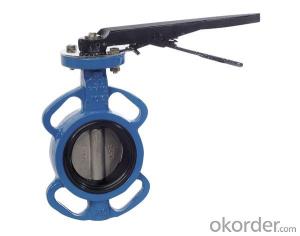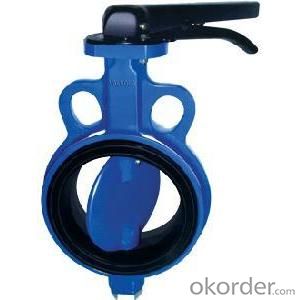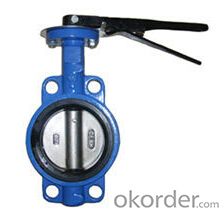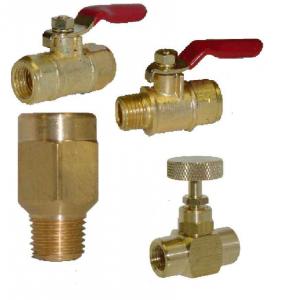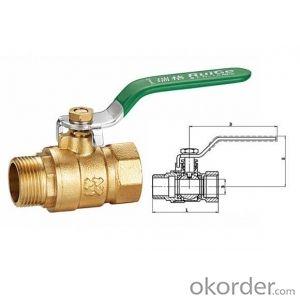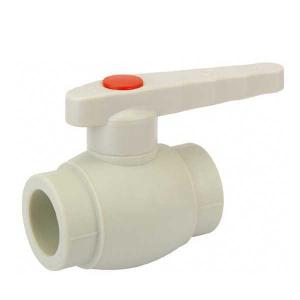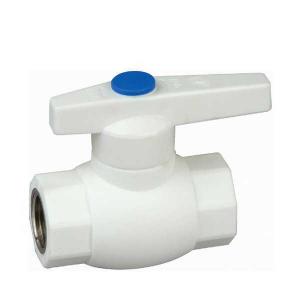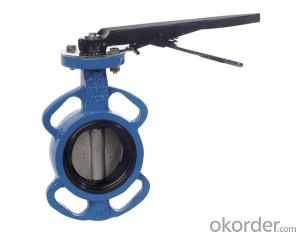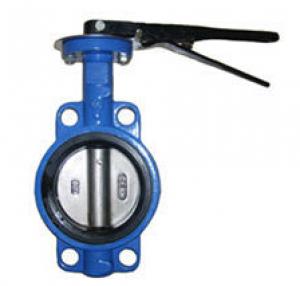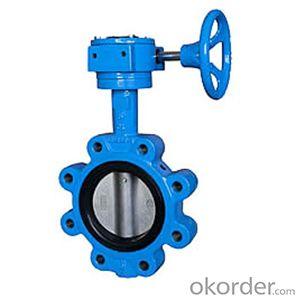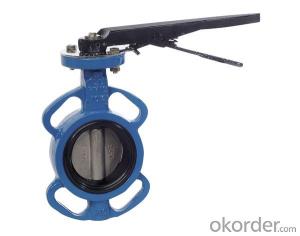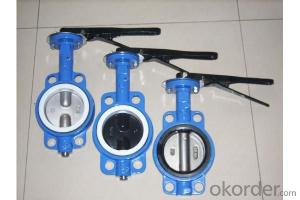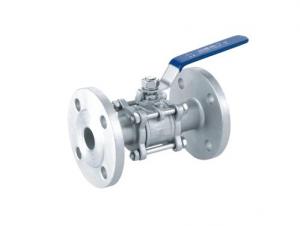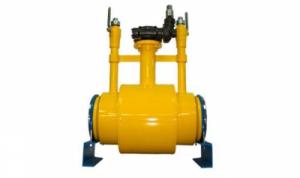Ductile Iron Butterfly Valves DN100 PN16
- Loading Port:
- China Main Port
- Payment Terms:
- TT OR LC
- Min Order Qty:
- -
- Supply Capability:
- -
OKorder Service Pledge
OKorder Financial Service
You Might Also Like
Cast iron valves
Size: DN40-1200 or 1.5-48' or above
Working Pressure: PN10/16/20/25, 150LB-2500LB
Suitable temperature: -45c~150c
Standard:
(1)Design and manufacture: DIN3352, BS5163, BS5150, ANSI B16.34, API600, API6D, API609, EN593, GB, T12238
(2)End connection: ANSI B 16.1, ASME B16.5, B16.47, B16.25, B16.34, JISB2212-JISB2214, DIN2543-2550, EN1092, AS2129, ISO 5211
(3)Wall thickness: API600, BS1868
(4)Face to face (end to end): EN 558, ASME B16.10, DIN3202, ISO5752, JIS, API609, MSS, BS5155
(5)Inspection and test: API598, EN12266-1, BS6755, API6D, ISO5208
Materialfor main parts:
(1)Body: CI, DI, WCB, ALB, CF8, CF8M
(2)Disc: DI, ALB, C95400, Rubber lined Disc, 1.2501, 1.4529, CF8M, CF8, Hastelloy
(3)Stem: SS416, SS410, SS304, SS431
(4)Seat: NR, Hypalon, EPDM, Neoprene, NBR, Wear-Resistant EPDM, Viton, Silicon, Heat-Resistant EPDM, WhiteNBR, WhiteEPDM, EPDM, PTFE
Coating: Fusion bonded epoxy coated
Connection type: Flanged type, Push-on type, Mechanical Joint type, Plain ends type
Sealing: Soft sealing or metal-to-metal seat, Flexible graphite
Operation: Manual, Pheunatic, Electric, Hydraulic and Pnewmatic-Hydraul
Appropriate medium: Air, water, sewage, steam, coal gas, oil
Packaging: Export polywood cases, or as per customers' requirements
Application: Fresh water, sewage, sea water, air, vapor, food, medicine, oils. Acids, alkalis, salt etc.
| Item | |
| | |
| | |
| | |
| | |
- Q: What are the differences between the pneumatic ball valve and the pneumatic angle seat valve?
- Pneumatic angle seat valve is the use of reciprocating actuators, usually in use to withstand fluid work pressure at 1.6MPa. Pneumatic ball valve is to use rotary actuator, to bear high fluid pressure. In normal use, the reciprocating actuator is characterized by its service life over the length of the rotary actuator. Two: easy maintenance. Three: the price is cheap. Personal recommendations in fluid pressure below 1.6MPa, or pneumatic angle seat valve is better?. High pressure, less opening frequency, pneumatic ball valve is appropriate.
- Q: What's the diameter of the 4 point ball valve?
- "4 point ball" in the "4 points" is based on the length of units per inch evolved;Divide 1 inches (25.4mm) 8, 4 points 4/8, or 1/2 inches, equal to 12.7mm.Therefore, "4 points ball valve" diameter is 12.7mm.
- Q: What are the uses and characteristics of copper ball valves?
- 4, good sealing performance5, the direction of installation is not limited, the flow of media can be arbitrary
- Q: Which one is more durable?
- Where can I distinguish it from the handle?!!In simple terms, the heavy ones need to wear a little longer
- Q: What are the advantages and disadvantages of the two functions of the pneumatic ball valve actuator?
- Pneumatic ball valve actuator is divided into double action and single action two modes of work.Working principle of double action mode:When the compressed air enters the middle cavity between the two pistons of the cylinder from the air inlet (2), the two pistons are separated and moved toward the two ends of the cylinder, and the air at the two ends of the air chamber is discharged through the air port (4). At the same time, the two piston rack synchronously drives the output shaft (gear) to rotate in an anticlockwise direction. On the contrary, when the air source pressure passes through the air inlet (4) into the air chamber at the end of the cylinder, the two piston moves toward the middle of the cylinder, and the air in the middle air cavity is discharged through the air port (2). At the same time, the two piston rack synchronously drives the output shaft (gear) to rotate in clockwise direction. (if the piston is mounted in opposite directions and the output shaft rotates in reverse direction, that is, double acting reverse type).
- Q: You can connect inside the pump and valve
- Pump and valve should be installed between the distance, too close, too far, will cause damage to the ball valve. The flange is usually used on the pump. Valve can be connected with a pipe with screw pipe, a head welding flange, and the flange is directly connected with the water pump. Super - Electronic Commerce
- Q: 3/4 on the elbow of the water pipe. How about that ball valve?
- 3/4 inches converted approximately equal to 20mm, that is, DN20, can be equipped with DN20 caliber ball valve, commonly used for brass material
- Q: What's the difference between a hot melt ball valve and a ball valve in general? What's the use of it?
- Ball valve (in the field of marine engineering and ships should be cut-off valve), standard GB/T21465-2008 "valve terminology" is defined as: "open and close parts (spheres) driven by the stem, and around the axis of the ball valve to rotate the valve movement.". Can also be used to regulate and control fluid, strong shear force between the metal seat seal V type ball valve V type ball core and welding hard alloy, especially suitable for containing fibers, small solid particles and other media. Switch and multi way valve in the pipeline not only can flow, and flow diversion, flexible control of the medium, but also to turn off any channel to the other two channels. This kind of valve should be installed horizontally in the pipeline. In accordance with the way to drive the ball valve is divided into: pneumatic ball valve, electric ball valve, manual ball valve.Ball valve was introduced in 1950s, with the rapid development of science and technology, production process and product structure of continuous improvement, in a short span of 40 years, has rapidly developed into a major valve category. In western developed countries, the use of ball valves is increasing year by year.
- Q: Our factory has part of the ball valve in the direction of movement and normal ball valve is the opposite direction: anti clockwise for the turn off, clockwise. Excuse me, what's the reason for this?Excuse me, is this because the valve body installs the reason of the contrary or the reason, the ball valve is thus designed?Are there any positive and negative points when the ball valve is installed?
- Ball valve is 90 degrees switch, you may put the handle of the wrong position, change 90 degrees, try it
- Q: What does one inch of an ice ball refer to?
- An inch refers to the valve's medium channel is%%C25mm
Send your message to us
Ductile Iron Butterfly Valves DN100 PN16
- Loading Port:
- China Main Port
- Payment Terms:
- TT OR LC
- Min Order Qty:
- -
- Supply Capability:
- -
OKorder Service Pledge
OKorder Financial Service
Similar products
Hot products
Hot Searches
Related keywords
